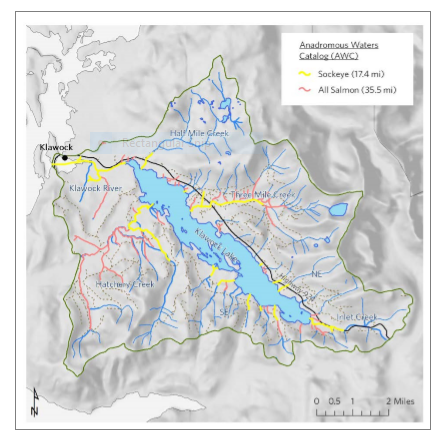The Nature Conservancy’s (TNC) Klawock Lake Sockeye Retrospective Analysis has been finalized and is available on their website.
TNC’s work in the Klawock Lake watershed is not done. They will be organizing both a public meeting and a stakeholder meeting over the next year (2017) to build common understanding of the history and current status of sockeye salmon and their habitats, and identify opportunities for stakeholders to partner on activities aimed to improve the condition of this resource. Please look for communication about these meetings in the near future.
You can find the report here and a quick glance at the Executive Summary is included below:
EXECUTIVE SUMMARY
Sockeye salmon from Klawock Lake have been important to people on Prince of Wales Island for thousands of years. Although the abundance of Klawock sockeye salmon has not been consistently monitored over this time period, it is evident that abundance over the last two decades is significantly less than historical values, and this has been a concern of local residents for some time. Because of these declines, there have been many previous efforts to address declines through research and management. This retrospective analysis serves as a single source of information regarding the many research, management, assessment, and watershed restoration projects that concern Klawock Lake sockeye salmon, presenting many of the relevant data and conclusions about Klawock Lake sockeye and the factors that may influence their productivity. Review of this previous research reveals that multiple factors likely conspire to influence the sockeye decline, and that while various research efforts have been completed over the years, significant data gaps still exist. Because climatic influences on sockeye salmon productivity are complex and ecosystem dynamics may be highly variable between individual systems, it is likely that some of the decline in sockeye productivity can be explained by natural causes. Long-term datasets on harvest and escapement, as well as lake and ocean conditions are not currently available, but would provide better insight into the relative importance of these factors. It is also likely that historic timber harvest practices have negatively impacted sockeye salmon spawning potential. Although a large amount of restoration in the watershed has likely been positive for fish habitat, a targeted systematic analysis of restoration most likely to benefit the most important sockeye spawning areas would be beneficial. The extent and effect of predation of juvenile sockeye, both by hatchery produced coho salmon and other predators, is also largely unknown and should be assessed. If predation is determined to be an important factor, then attempting to adjust temporal or spatial overlap between predators and juvenile sockeye could be effective. Improvements to harvest management could be considered, including validation of harvest and escapement estimates, estimation of the contribution of the commercial fishery to total harvest, and a management regime to encourage a locally-driven conservation-based approach to harvest, especially in years with poor sockeye returns. To be effective, research and management activities will require a collaborative approach between multiple stakeholders to ensure lasting results.

